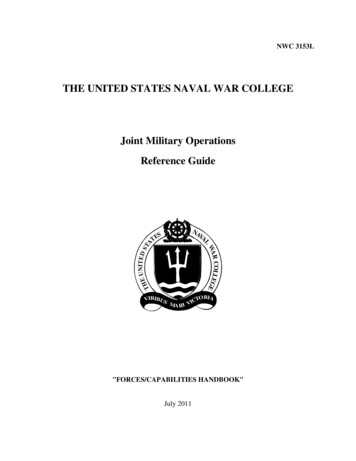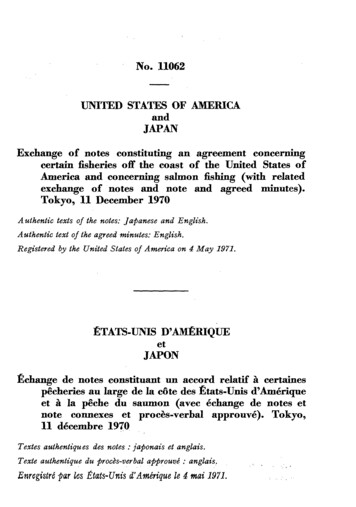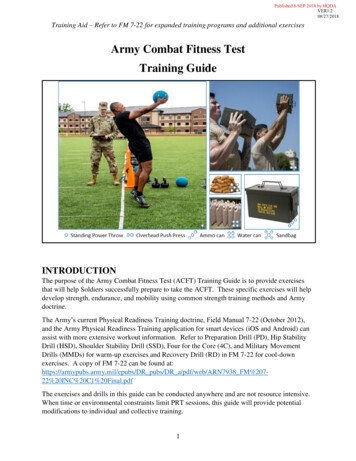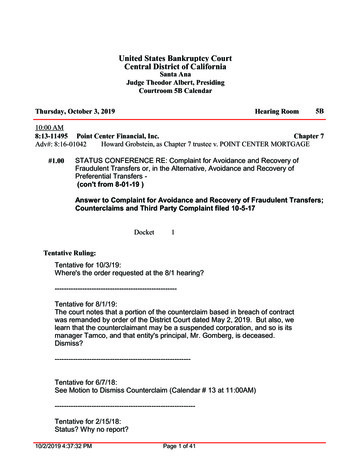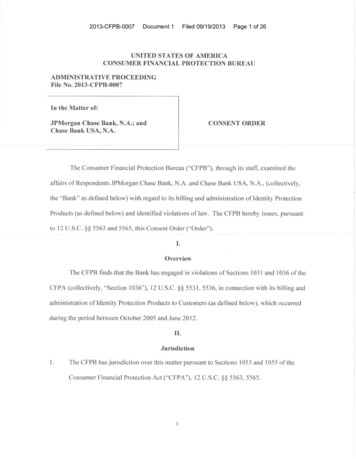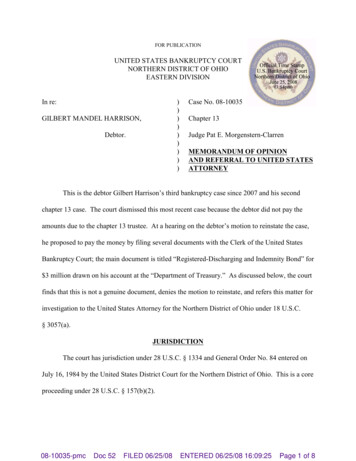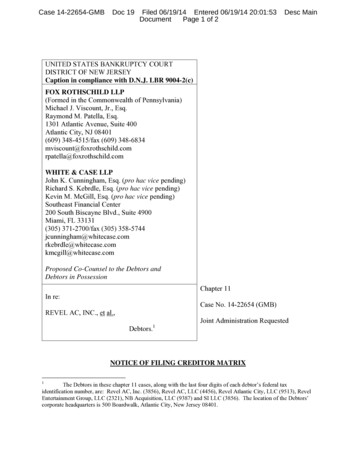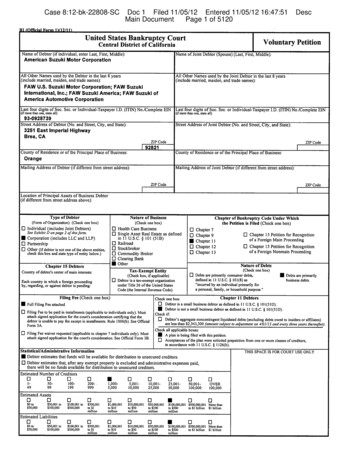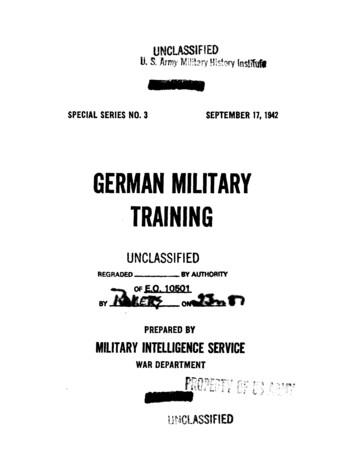
Transcription
UNCLASSIFIEDS. 'ArmyiWi anyij Hl.ry Inslq*nSPECIAL SERIES NO. 3SEPTEMBER 17, 1942GERMAN MILITARYTRAININGUNCLASSIFIEDREGRADED-BY AUTHORITYPREPARED BYMILITARY INTELLIGENCE SERVICEWAR DEPARTMENT:i CLASSIFIED
MILITARY INTELLIGENCESERVICESPECIAL SERIESNo. 3WAR DEPARTMENTWashington, September 17, 1942MIS 461NOTICE1. The information summarized here is based on a variety of sources: onGerman manuals, on technical articles in German military reviews, andabove all on the detailed reports of United States observers who saw theGerman Army at close range in its work of preparing for this war andduring the first 2 years of conflict.2. Nondivisional units are being supplied with copies on a basis similarto the approved distribution for divisional commands, as follows:INF DIVDiv Hq -8Rcn Tr ----- 2Sig Co --------2Engr Bn - -7Med Bn .------7QM Bn - -7Hq Inf Regt, 6 each 18Inf Bn, 7 each --- 63Hq Div Arty- 8FA Bn, 7 each 28150CAV DIVDiv Hq - 8Ord Co:.--------2Sig Tr 2Rcn Sq -------- 7Engr Sq ------ -7Med Sq - --- 7QM Sq----------7Hq Cav Brig, 3 each 6Cav Regt, 20 each 80Hq Div Arty 3FA Bn, 7 each-- - 21150Distribution to air units is being made by the A-2ARMID DIVDiv Hq .Rcn Bn-Engr Bn.Med BnMaint Bn - Sup Bn -Div Tn HqArmd Regt, 25 eachFA Bn, 7 each---Inf Regt -11777778502125150of Army Air Forces.3. Each command should circulate available copies among its officers.Reproduction within the military service is permitted provided (1) thesource is stated, (2) the classification is not changed, and (3) the information is safeguarded. Attention is invited to paragraph 10a, AR 380-5which is quoted in part as follows: "A document * * * will be classifiedand * * * marked restricted when information contained therein is forofficial use only, or when its disclosure should be* * * denied thegeneral public."4. Suggestions for future bulletins are invited. Any correspondencerelating to Special Series may be addressed directly to the Evaluation andDissemination Branch, Military Intelligence Service, War Department,Washington, D. C.48081 o-42---1cI4808810-42--1
CONTENTSPageSECTION I.II.INTRODUCTION TRAINING IN.-------PREPARATION-1FOR MILITARYSERVICE- - - -- .31. General.-----------2. Training of the German Youth ----a. The Hitler Youthb. Labor Service----------------3. Conclusion ----------------------35589III. WORK OF THE SA (STORM TROOPERS)----104. General ----------------------5. The SA as a Military Reserve -----6. Conclusion ---------------------IV.PROCUREMENT AND TRAINING OF OFFICERS7.8.9.10.V.General ------------------Officer Training prior to the War-.Training during the War .-.Continuation Training of Officers. - -STANDARDS FOR OFFICERS -10101213131415161911. General .- --------------- --.--.1912. Character ---------------------2113. Relations of Company Officers withEnlisted Personnel --. 23VI. PRINCIPLES OF LEADERSHIP.-------------2614. General-----------.----------2615. The Task-Force Principle: CombinedOperations.-.-2616. Aggressiveness and Initiative -----2917. Orders and Communications-----32a. Orders.33b. Communications------------.3618. Knowledge of Terrain. 3819. Surprise -------------.-------39III
CONTENTSIVPageVII. TRAINING METHODS20.21.22.23.24.Physical Condition and Marching .Emphasis on Field Exercises ------Realism -----------------------Thoroughness ------------------Marksmanship -------------404041434546VIII. GERMAN OFFICER CANDIDATES SCHOOL .4725. Introduction .26. Text of the Report ----------4747APPENDIX A. MANEUVERS AND FIELD EXERCISES: UMPIRE ------.53Purpose of Maneuver54General Missions of Umpires 54Organization of Umpire Staff -------------58Umpire Regulations and Explanations ------61Hostile Fire and Its Effect -------.Sample Announcements by Umpires during anExercise ------------------. 6365Common Mistakes of Umpires ------------68.The Umpire ConferencesConsiderations for Umpires after the UmpireConference but before and during the Ma69neuver --------------------------------Unit Procedure and Control by Umpire Situ75ations ----------------------------------Mistakes, Their Penalties and Corrections ng with Sand Tables ----------------.83Concluding Remarks ----------------------84Comments by U. S. Observer -----------
CONTENTSVPage.APPENDIX B.COMBAT TRAINING OF THE RIFLE SQUAD.1. The Preparatory Work of the Platoon Commander - ---a. Plans ------------------------------b. Theoretical Instruction ----------------c. PreparatoryWork zn the Field ----------d. Plan of Action --.-942. The Practical Work of the Platoon Commanderas Instructor --------a. General--.------------- .b. Execution of tlte Problem -------c. Concluswon-------------------898990929999100105
Section L. INTRODUCTIONThis bulletin proposes to summarize informationwhich will serve three purposes:1. It will permit a better appreciation of the basisof German military strength.The strength of the German Army and its earlysuccess in this war owe much to two factors: planning and training. The Nazi leaders planned thiswar for years in advance of their attack. They prepared for it by a system of military training whichbegins with children of high-school age. The training system was directed by the old professionalarmy: it depended on effort, thoroughness, and theapplication of old and tested principles to the meansof modern warfare. As an observer remarks, theGermans believed that by hard work and hard training they would "save blood later." This traininggave the German army a time advantage over itsrivals, although this advantage is being steadilyreduced.2. It will contribute to our knowledge of characteristic German tactics.1
2GERMAN MILITARY TRAININGThose principles of tactics and leadership whichare emphasized in training are inevitably reflectedin the actual conduct of operations. While this bulletin will make no detailed study of German tactics,it will bring out the main doctrines which are appliedin battle as a result of training.3. It will suggest methods and points of view whichmay be useful in training U. S. troops.There are many basic similarities between U. S.training doctrines and those of the German Army,though there are naturally many differences in theiruse or application. We can learn from the differences as well as the similarities. As far as possible,concrete examples have been given, and in the appendixes there are detailed illustrations, at somelength, of certain phases of German trainingmethods.
Section II. TRAINING IN PREPARATION FOR MILITARY SERVICE.1. GENERALThe Nazi government from the start was dedicatedto the purpose of a war of conquest; and from 1934on, the Party controlled and directed every aspect ofGerman life to this aim. German military leadershave followed Clausewitz for years, but only underthe Nazi regime could his key concept of total warbe realized: the principle that every agency and everyindividual of a nation must be used in the effort ofwar. Nothing is more revealing of Nazi plans andmethods than the application of this principle in avery broad program of military training.The goal of this program was a large and highlytrained army, but the shaping of this army was notleft to the 2 years of actual military training for conscripts. From the age of 14, boys were to receive apreparation for military service which would covermuch of the basic training ordinarily given recruits.In addition, men older than conscript age, with or3
4GERMANMILITARY TRAININGwithout previous military service, were to be givenvarious types of auxiliary, background, or "refresher" training.The Nazi Party, through its various branches, wasmainly responsible for civilian training outside thearmy proper. This included due concern for specialized training in skills needed for mechanized warfare.A National Socialist Flying Corps sponsored instruction in the rudiments of flying and in glider practice.The National Socialist Motor Corps trained a largereserve of youths in all types of driving for mechanized service, and thus relieved army motor schools ofmany hours of instruction. A German article in 1940claimed that 125,000 men had been given'experiencein "military motorization." A Motor Boat Corpscooperated with the Army and Marines to preparemen for water-transport operations.The activities of the Party are particularly concerned with the indoctrination of all German citizensfor war. The basic ideas in this indoctrination arewell known and are reiterated in Hitler's speeches:the theory of Germany's "natural" rights; the concept of the "master race"; the exaltation of state andleader; the glorification of war and military virtues,etc. The schools, press, radio, and movies are controlled by the Party and support its efforts in everydirection by propaganda which has to fear no rival;the penal code prevents any free discussion in the fieldof ideas. Every German household belongs to a localunit (Block) organized to carry out the Party educational program.
TRAINING FOR MILITARYSERVICE5A German lieutenant has summed up this work ofindoctrination:In his parent's home, in school, in the Hitler Youth, in thesubdivisions of the movement, in the shop, and in the LaborService, the future Army recruit has been bred as a NationalSocialist: he does not know anything else but allegiance to theNational Socialist State, and the life work of being a German.2. TRAINING OF THE GERMAN YOUTHa. The Hitler YouthAt the age of 10, German boys are brought into theNazi scheme as members of the "Young Folk" (JungYolk) organization, and receive their first taste ofofficial indoctrination. Real shaping for the armybegins at 14, when they enter the "Hitler Youth"(Hitler Jugend).Even before the war, this organization was mainlyconcerned with preparing boys for the army, both byinstilling military mental attitudes and by militarytraining. A U. S. observer gives the following description of an exercise of German boys carried outon a Sunday morning:Two groups, one of mixed Hitler Jugend and Jung Volk, 30strong, and the other a similar group of 22 cyclists on 11 bicycles, marched into Gruenewald Forest under the command ofa Hitler Youth. This boy appeared to be 15 or 16 years of age.He halted his command, dressed it with skill and precision, andannounced his mission in a clear and definite manner: "Theenemy is reported advancing from south to north throughGruenewald Forest. At 7 o'clock he was reported to be enter-ing** *. My mission is to determine at once, and report
6GERMAN MILITARY TRAININGto headquarters, the position and activity of its advance units.My sector is * * *"It will not be necessary to go into the young commander'sestimate of the situation and his orders to his subordinates.They would have done credit to a professional Army officer.That boy, still 2 or 3 years from active service as a private inthe Army, was able to estimate a difficult situation, and organize and put into execution a rather complex plan to carry outhis mission on a sector nearly 1,000 meters wide. This demanded an extended series of rapid-fire orders. It was evidentthat he had control of his boys. A continuous stream of bicycle messengers carried reports from advance units to the leader'spost. He, in turn, sent frequent written messages to some postto his rear.The observer was frankly amazed at this performance andspent the entire morning with this group. To be sure, therewas a certain amount of laughing and horseplay among theboys. This was not repressed; but any lack of attention toduty called forth immediate and severe rebuke from the leaders. It was evident that the youngster in charge was on hisown. Some other means must have been provided for checkingup on how well that youthful commander had accomplished hismission.Two of his units-one boy each-failed to follow instructions. Some were lost, and some had difficulty in reportingclearly what they saw; some failed in their individual missions. But the boy leader did not fail in his. He finallyrecalled all units with skill, marched them to the rear, and veryably praised and criticized individual performance.On the whole, it was a remarkable demonstration of howGerman military leadership is developed.Another observer saw Hitler Youth organizationsengaged in battalion maneuvers, and reports thattheir performance would be creditable to regulartroops.
TRAINING FOR MILITARY SERVICE7In 1939 the Storm Trooper section of the Naziparty took charge of the Hitler Youth, and afterthe start of war boys 16 to 18 years of age werecompelled to take 6 months of regular pre-militarywork. The aim was to provide the army with thelargest possible reserve of "mentally, physically, andmilitarily trained young men. " The training includesinfantry fundamentals, care and use of weapons, andsignaling. The Hitler Youth has been used in a variety of auxiliary services during the war: spotting aircraft, performing office work at airports, paintingrunways, harvesting crops, tending children in daynurseries, collecting useful junk and trash, solicitingfor the Winter Help, singing at hospitals, and puttingon entertainment for soldiers at the front.The following statistics, based on estimates by aU. S. observer, suggest the scope and variety of HitlerYouth activities:(1) The National Socialist Flying Corps furnishedthe Hitler Youth fliers with enough gliders, planes,and instructors to teach 135,000 boys how to fly eachyear.(2) The motorized units of the Hitler Youth enrolled 295,000 boys each year. The National SocialistParty set up 1,300 repair shops for the units, and eachyear provided them with 5,000 motorcycles.(3) The Hitler Youth Marines had an annual enrollment of 78,000.(4) The National Socialist Party supplied theHitler Youth with 10,000 revolvers a year and a larg
instilling military mental attitudes and by military training. A U. S. observer gives the following de-scription of an exercise of German boys carried out on a Sunday morning: Two groups, one of mixed Hitler Jugend and Jung Volk, 30 strong, and the other a similar group of 22 cyclists on 11 bi- cycles, marched into Gruenewald Forest under the command of a Hitler Youth. This boy appeared to be .
